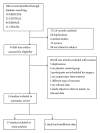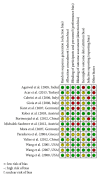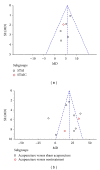Efficacy of acupuncture in reducing preoperative anxiety: a meta-analysis
- PMID: 25254059
- PMCID: PMC4165564
- DOI: 10.1155/2014/850367
Efficacy of acupuncture in reducing preoperative anxiety: a meta-analysis
Abstract
Background. Acupuncture has been shown to reduce preoperative anxiety in several previous randomized controlled trials (RCTs). In order to assess the preoperative anxiolytic efficacy of acupuncture therapy, this study conducted a meta-analysis of an array of appropriate studies. Methods. Four electronic databases (MEDLINE, EMBASE, CENTRAL, and CINAHL) were searched up to February 2014. In the meta-analysis data were included from RCT studies in which groups receiving preoperative acupuncture treatment were compared with control groups receiving a placebo for anxiety. Results. Fourteen publications (N = 1,034) were included. Six publications, using the State-Trait Anxiety Inventory-State (STAI-S), reported that acupuncture interventions led to greater reductions in preoperative anxiety relative to sham acupuncture (mean difference = 5.63, P < .00001, 95% CI [4.14, 7.11]). Further eight publications, employing visual analogue scales (VAS), also indicated significant differences in preoperative anxiety amelioration between acupuncture and sham acupuncture (mean difference = 19.23, P < .00001, 95% CI [16.34, 22.12]). Conclusions. Acupuncture therapy aiming at reducing preoperative anxiety has a statistically significant effect relative to placebo or nontreatment conditions. Well-designed and rigorous studies that employ large sample sizes are necessary to corroborate this finding.
Figures






References
-
- Ramsay MA. A survey of pre-operative fear. Anaesthesia. 1972;27(4):396–402. - PubMed
-
- Czeisler CA, Ede MCM, Regestein QR, Kisch ES, Fang VS, Ehrlich EN. Episodic 24 hour cortisol secretory patterns in patients awaiting elective cardiac surgery. Journal of Clinical Endocrinology & Metabolism. 1976;42(2):273–283. - PubMed
-
- Johnston M. Pre-operative emotional states and post-operative recovery. Advances in Psychosomatic Medicine. 1986;15:1–22. - PubMed
-
- Wallace LM. Trait anxiety as a predictor of adjustment to and recovery from surgery. British Journal of Clinical Psychology. 1987;26(1):73–74. - PubMed
-
- Kain ZN, Mayes LC, Bell C, Weisman S, Hofstadter MB, Rimar S. Premedication in the United States: a status report. Anesthesia and Analgesia. 1997;84(2):427–432. - PubMed
Publication types
LinkOut - more resources
Full Text Sources
Other Literature Sources
Medical

